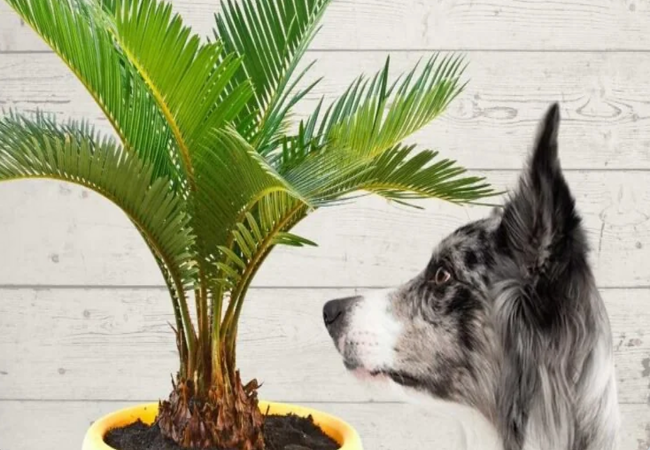Sago Palm Poisoning in Dogs: A Vet’s 2025 Comprehensive Guide ☠️🐶

In this article
Sago Palm Poisoning in Dogs: A Vet’s 2025 Comprehensive Guide ☠️🐶
By Dr. Duncan Houston BVSc
1. What Is a Sago Palm?
Sago palms (Cycas revoluta and related cycads) are ornamental plants commonly used in landscaping across warm climates, and sometimes indoors as bonsai.
Though they look palm-like, they belong to an ancient group of gymnosperms. Every part of the plant—including leaves, stems, roots, and especially the seeds—is highly toxic to dogs.
2. Why It's So Dangerous 🧪
Sago palms contain:
- Cycasin: a gastrointestinal irritant and hepatotoxin (causes liver damage)
- β-Methylamino-L-alanine (BMAA): a neurotoxin causing tremors, seizures, and collapse
- An additional unidentified toxin is linked to neurological signs.
Even a single seed can deliver a fatal dose—mortality rates reach 50–75% in dogs.
3. Timeline of Toxic Effects
Onset can be rapid or delayed:
- Within minutes to hours: drooling, vomiting (sometimes bloody), diarrhea, lethargy.
- By 4–12 hours: neurological signs—ataxia, tremors, seizures, collapse.
- Within 2–3 days: acute liver failure—with jaundice, ascites, bleeding, coagulopathies, dark urine, melena, nosebleeds, and abdominal pain.
Late complications like thrombocytopenia, hypoglycemia, or hepatic encephalopathy are possible.
4. Recognizing Symptoms
- 🤢 Vomiting, diarrhea (± blood)
- 🥱 Lethargy, weakness, loss of appetite
- 🧠 Neurological: wobbling, tremors, seizures, coma, collapse
- 💛 Jaundice (yellow eyes/gums/skin)
- 🩸 Bleeding: nosebleeds, bruising, melena, hematuria
- 💦 Increased thirst/urination, fluid buildup in the abdomen
These signs are hallmark red flags. Immediate action is vital: any known or suspected ingestion—even a nibble—warrants emergency care.
5. What to Do Immediately
- 🚨 Get your dog to a veterinary clinic immediately—don't delay!
- 📞 Call ahead to alert the vet about suspected sago palm ingestion.
- 📸 Bring a sample or photo of the plant for accurate identification.
- ⛔ Do NOT induce vomiting at home unless directed—aspiration pneumonia & worsening signs can occur.
6. Veterinary Treatment 🏥
- Decontamination: Hospital-induced emesis if early (<4 hrs), followed by activated charcoal via nasogastric tube.
- Supportive care: IV fluids, electrolyte correction, antiemetics, gastroprotectants.
- Liver protection: antioxidants, SAMe, silybin, vitamin K for coagulopathy, plasma transfusions.
- Symptomatic therapy: anticonvulsants, oxygen therapy.
- Diagnostics: CBC, chemistry, liver panels daily for 72+ hrs; imaging if fluid/bleeding suspected.
- Hospitalization: 48–72 hrs or longer for monitoring and complication management.
Early, aggressive intervention dramatically improves chances of survival.
7. Prognosis & Long-Term Care
- 🟢 Early treatment: up to 50–75 % survival; recovery possible with no long-term liver disease.
- 🟠 Delayed treatment: high risk for permanent organ damage, chronic liver disease, bleeding disorders, or neurological disability.
- 🔴 Severe cases: poor prognosis with fulminant liver failure or uncontrollable seizures.
- Follow‑up: periodically check liver function, clotting, and glucose for several weeks. Consider ongoing liver support medications if needed.
8. Prevention & Yard Safety 🌴
- ❌ Avoid planting sago palms or similar cycads (e.g., cardboard palm, Macrozamia) in yards or homes.
- 🔍 Survey your property and neighbors’ yards—remove any and dispose safely.
- 🐶 Keep curious dogs leashed and discourage sniffing/chewing when walking.
- ✅ Fence off garden beds or use raised planters that are inaccessible to pets.
- 📚 Educate family, guests, and landscapers about the plant’s dangers.
- 🧼 Clean fallen plant debris promptly—fronds and seeds can blow into yards.
9. Ask A Vet Support & Resources
- 📱 Ask A Vet App – 24/7 pet poison triage for suspected ingestion.
- 🎓 Webinars and fact sheets on toxic plants and yard safety in 2025.
- 🛠️ Woopf & Purrz Safety Kits™ – include plant spotter cards, yard audit checklists, emergency flowcharts.
10. Final Takeaway 🚨
Sago palms rank among the deadliest plant hazards to dogs. In 2025, keeping pets safe means eliminating risky flora, watching symptoms carefully, acting swiftly, and seeking veterinary care without delay. Early intervention can mean the difference between life and death. Stay vigilant, stay safe, and protect your four-legged family 💚🐾.
Think your dog may have eaten a sago palm? Visit AskAVet.com or open our app—veterinary help is just one immediate step away.


